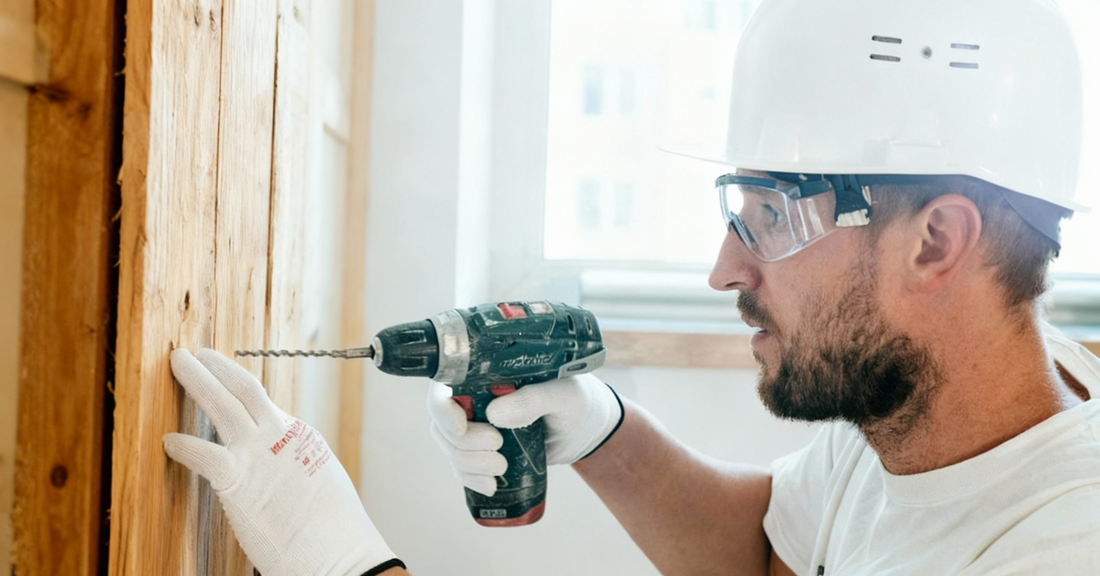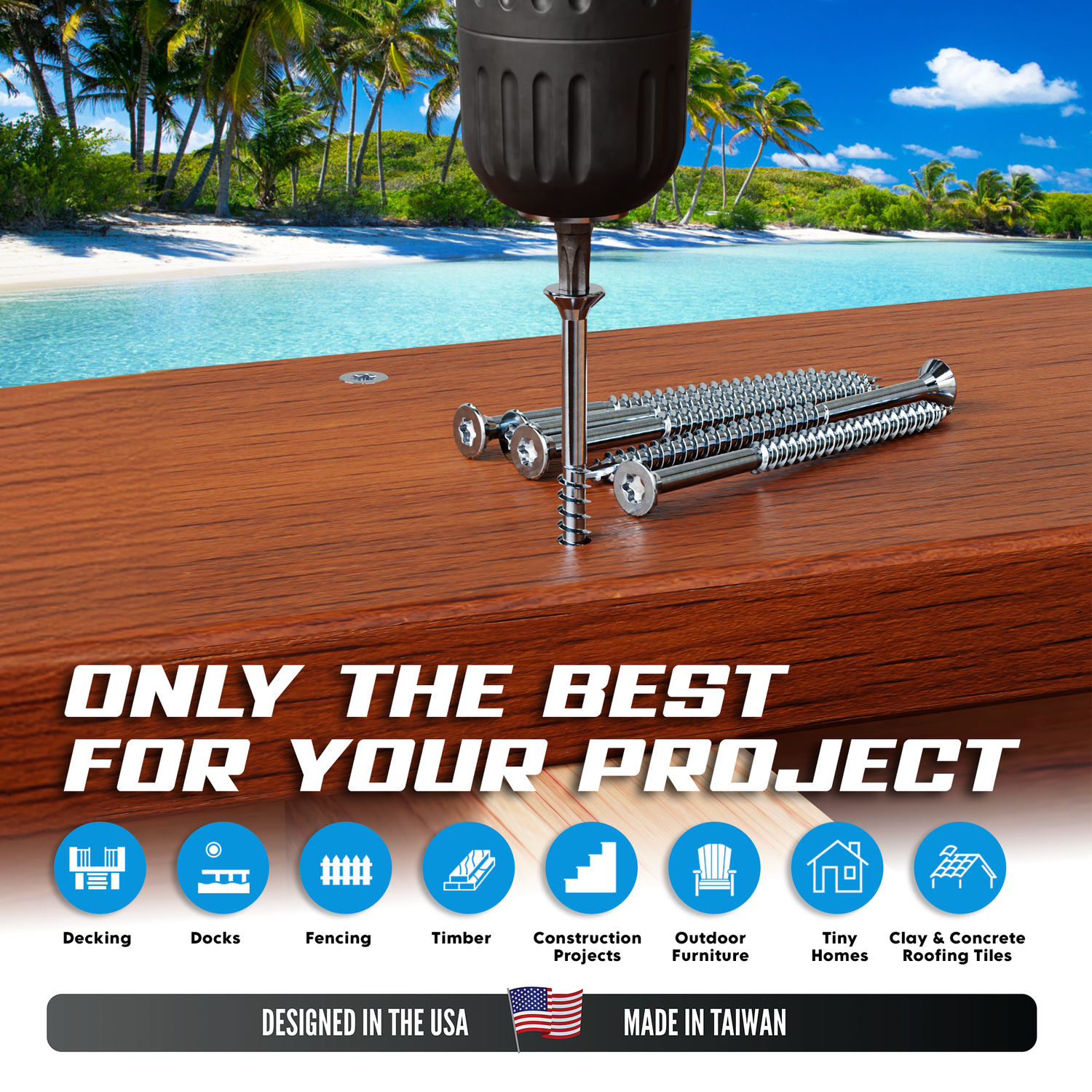
31 Drill Safety Tips for ZERO-Injury Timber Construction Projects
Share
We’ve been building timber structures for years, and other than making sure we’re building something that can last for years, our main priority is keeping every member of our team safe.
Now, we’re teaching aspiring contractors (and DIYers) how to keep the worksite safe and, hopefully, never get a call back from a client or a citation from OSHA.
These 31 drill safety tips are from our own professional experience in building all kinds of wood structures, using all types of power tools and screws in different weather conditions.
TL;DR (What are the safety rules for power tools with screws?)
- Use the right screws and drill bits.
- Align your shoulder, not your wrist, when driving screws.
- Always pre-drill holes.
- Use the right torque/speed.
- Always use Torx screws.
- Always use stainless steel screws to prevent rust.
- Only buy from trusted wood screw brands like Eagle Claw Fasteners.
- Follow the Hand and Power Tool Safety Rules from OSHA.
The Dangers Of Using Drills and Driving Screws The Wrong Way
Driving screws the wrong way isn’t just about stripping screws; it can also result in issues that lead to injuries and contractors losing clients.
Physical injuries
Improper handling, the wrong bit, or the wrong screw size can result in cuts and punctures. But not only that, it can also lead to driving a screw into your hand instead of the wood. There are horror stories like pushing an impact driver so hard that the tip jumps and mangles a finger.

Moreover, if fixings are undersized or installed wrong, things come loose and fall. A missed pilot or a too-short screw can let a piece drop and put people below at risk.
Rework and delays (time equals money)
Wrong fasteners loosen, strip, or break. That means tear-outs, do-overs, and lost time. Pulling apart a section because screws keep spinning in their holes is a classic schedule killer. So, instead of building a deck for a new client, you’ll end up doing do-overs with no new revenue coming in.
OSHA citations
You don’t want to wait until you get fined by the Occupational Safety and Health Administration to be familiar with what they require when it comes to power tool safety. It’s not just about the citations, however; you’ll get frequent visits by them, and that would lead to a delay on your projects.
Destroying your company’s reputation
For contractors, improper installation can eventually lead to losing future clients. Everyone wants to get their money’s worth, and your clients will take the time to inspect your work throughout the build.
If they see you’re using decking screws instead of structural screws for the brackets, expect a negative review on every online platform they can find. Or worse, start a Reddit thread branding your company as the one that ripped them off.
If they ask for safety records and you can’t provide them enough proof, they’ll find another contractor who can give them adequate records.
As professional timber construction professionals, we were able to thrive in the industry for years by following the power tool safety from OSHA and the hard-earned fastening habits below. We’ll teach you what we’ve learned in years in just a matter of minutes.
OSHA Requirements for Power Tools

1. PPE: Wear safety goggles and gloves when drilling/driving.
2. Apparel: No loose clothing, jewelry, or untied hair around rotating bits.
3. Workspace: Keep floors clean and dry; keep the area well lit.
4. Bystanders: Keep people not involved out of the work zone.
5. Secure the work: Clamp or vise the material so both hands run the tool.
6. Guards & switches: Drills must have guards and a constant-pressure trigger that shuts off when released. Do not tape triggers.
7. Avoid accidental starts: Don’t carry a plugged-in drill with a finger on the switch.
8. Cords & hoses: Never carry by the cord; don’t yank to unplug; route away from heat, oil, sharp edges, and trip paths.
9. Power disconnect: Unplug/take the battery out when not in use. Whether you're changing bits, cleaning the drill, or servicing it, disconnect it from the power source first.
10. Tool condition: Keep drills clean and the bits sharp. Only use the tool on jobs that it is designed to do. Drills and bits are for driving screws and not as mixers, grinders, or pry bars. Follow the manufacturer's recommendations for lubrication and accessory changes.
11. “Do Not Use.” label on damaged tools: Remove them from service to ensure your employees are using drills that they can properly control. Not only does this prevent injuries, but also prevents slippage.
12. Footing & stance: Maintain good balance and stand square to the work.
13. Wet locations: Don’t use drills in damp/wet spots unless approved for it.
14. Construction sites: Protect users with GFCI or an assured equipment-grounding conductor program.
15. Storage: Store electric drills dry when not in use.
16. Footwear: Wear appropriate safety footwear when operating electric drills.
Important: You can get a copy of the Hand and Power Tools booklet by OSHA here. However, we encourage that you find an authorized provider of power tool safety training so your employees can have a better and full understanding of the OSHA requirements.

Speeds, Clutch & Torque Control
17. Use the Right Drill Speed: Drills usually have 2 settings: 1 = low speed, high torque, and 2 = high speed, low torque. Start your screw on 1 for control, then only bump to 2 for drilling pilot holes. Then come back to 1 for driving, so the bit doesn’t slide across the surface.
18. Clutch feel and impact feedback: Feedback is a big part of it. Learn to tighten and stop at the torque you want by feel, since the drill’s clutch number may not match that feel, and an impact driver gives even less feedback. Use wood scraps to map the feel to numbers: “This plank lands at 7,” “This hinge lands at 4.”
19. For impacts, count pulses: Two or three clicks after contact are plenty on thin wood pieces. If you’re driving in longer or structural screws, it may take more than three. Over time, you’ll learn to read the sound and pulse to stop on time.
Pilot Holes, Countersinking & Tough Materials
20. Pilot holes and countersinking save wood and screws. Pre-drilling helps prevent splitting. Countersinking keeps the head from chewing the surface. Match your pilot to the screw’s core (not the outer thread) so the threads do the gripping. Use a countersink or a combo bit so the head seats clean. For thin stock, clamp it or back it up with scrap.
21. Using screws with sharp points for easy starts helps. Wood screws with Type 17 points, like Eagle Claw, cut in quickly, and nibs under the screw head help the head settle flush without tearing the surface.
Bits, Heads, Holders & Staying Square
22. Only use Torx screws. Philip screws aren’t designed for today’s drill speed or torque, so they strip easily. Use screws with Torx sizes like T20 or T25, like Eagle Claw wood screws. These screws give a solid bite and less cam-out. Eagle Claw’s Torx screws hold on even at a weird angle, like when you’re installing drawer slides inside a wooden cabinet box.
23. Using the right drill bit. Using the right bit makes a big difference when it comes to stripping. Screw heads come in many sizes, and the simple way to test and make sure you're using the right one is to simply push the bit into the screw head and see if it rocks or wiggles. If it wiggles, it’s the wrong size; there’s no “maybe.”
24. Buy quality bits. Most contractors trust Milwaukee, DeWalt, and Makita. You can buy cheap no-brand bits, but they round off faster.
Established wood screw brands, like Eagle Claw Fasteners, include a driver bit for every purchase, and they also sell them separately. But you’ll find Amazon reviews that the free driver bit is enough for every pack of Eagle Claw wood screws. That’s why they’re on the list of the top deck screw brands!
25. Retire worn bits early. Once it slips, it’ll slip again. If you see shiny, rounded corners on the bit or feel it slip once, swap it. A square start is faster than fixing a chewed head.
Ergonomics, Workflow, Wrist & Strength
26. If you’re dealing with less grip strength or sore wrists, get a multi-speed impact driver. Unlike a drill that can wrench your wrist when a screw stops, an impact driver won’t impart nearly as much torque to your wrist as a drill does. Milwaukee’s M12 or M18 Fuel Surge is quiet, controllable, and strong.
27. Keep your drill perfectly over the screw. Stand square to your work so your shoulder, not your wrist, takes the load. If the tool surges at the start, pre-spin the bit with almost no pressure to seat it. Then lean in and go.'

28. Get two batteries so you’re never dead on the job. Cordless drills with lithium batteries have good run times. However, if you’re building large commercial decks requiring a lot of long structural screws, you need a spare battery.
Swap batteries before they’re flat, since a weak battery can stall and chew heads.
Screw Quality, Types & Brands
29. Don’t buy cheap screws. Sure, you’ll save a few cents by buying no-brand screws from big box stores, but these screws strip easily. Torx screws are typically more expensive but are totally worth it. You can take them out and reuse them, so you’ll save more by buying premium screws. These screws stay engaged when you’re off-balance or reaching.
30. Not using stainless steel screws. Stainless steel wood screws might be more expensive than coated screws, but they’re the only screws that are going to outlast your cedar deck.
31. Choose the right grade of stainless steel screws. If you’re living in areas where it’s moderately humid, you can use 304 / 305 stainless steel screws. However, if you’re living in coastal areas, say in Florida, you’ll have to use 316 stainless steel screws.
Eagle Claw Fasteners are designed for all outdoor conditions. The screws’ sharp threads bite and hold even when the wood swells and shrinks due to temperature changes.
Only Buy from the Wood Screw Brand that Thousands of Builders Trust
Eagle Claw Fasteners has sold tens of millions of wood screws over the years and has become the top wood screw supplier for contractors in the United States, Canada, and the United Kingdom.
Eagle Claw stainless steel wood screws match the big names on holding power, strength (no broken screws!), and corrosion resistance. Partner with Eagle Claw and make stainless an easy yes on every job.
At our core, we are contractors, so we know what it takes to survive in this competitive industry, and that’s why we’ve designed these OSHA- and client-approved screws.
Sign up as a building contractor or deck builder and receive an exclusive 10% off every order that you place. Register today and never miss an opportunity to save big!


